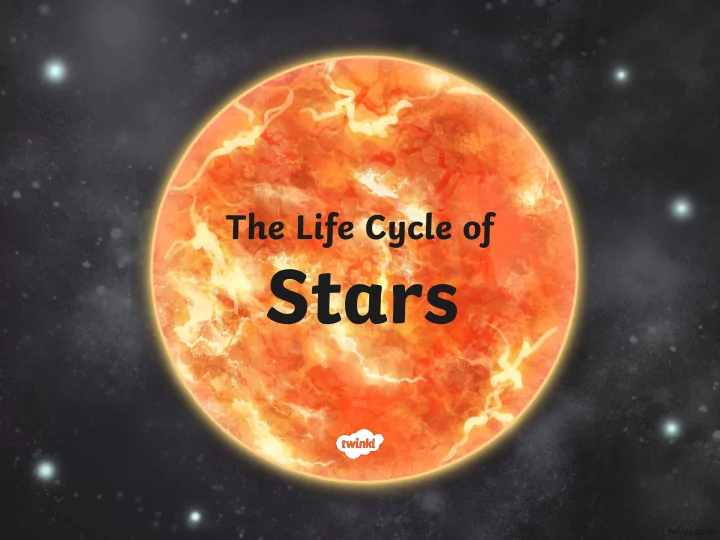

The Life Cycle of Stars
Stars Stars form from massive clouds of dust and gas in stellar nurseries.
Stars Gravity pulls the dust and gas together creating heat in the process.
Protostar A protostar is the first stage in a star's life. They are formed when gas in space is pulled together by gravity to form a cloud. As this happens, the gas pressure and magnetic pressure made by the cloud tries to pull itself apart. This eventually makes the gas collapse.
Life Cycle The life cycle of a star depends on its size. Stars smaller than the Sun. Sun-like stars. Giant stars.
Main Sequence During the main sequence life of a star, the forces inside and out are balanced and it can remain stable for billions of years.
Red Dwarf These are stars smaller than the Sun which burn fuel more slowly and exist at cooler temperatures. They remain on the main sequence for much longer than bigger stars and are much dimmer and harder to see. It is thought that 20 of the 30 closest stars to Earth are red dwarf stars. Red dwarf stars burn fuel at a rate that means they can shine for trillions of years – much longer than the current age of the universe. That means that none have moved on from the main sequence yet, but it is thought that when the fuel runs out, they will suffer the same fate as Sun- sized stars.
Red Giant A red giant is a star in a late stage of its life. Very large stars at this stage are known as 'red supergiants' and are the biggest stars in the universe. As the fuel begins to run out, the rate of the reaction slows down. The centre of the star cools and the outside heats up, expanding in the process.
Planetary Nebula The outer parts of the star drift away to form a cloud of dust called a planetary nebula.
White Dwarf The hot core of the star cools and becomes a white dwarf and then finally a black dwarf when all remaining heat is lost through radiation and the star ‘dies’. white dwarf black dwarf
Supernova A supernova is the explosion of a star. A star explodes either when it gains too much matter, or when it runs out of nuclear 'fuel'. A supernova explosion can burn with the brightness of 100 million Suns!
After a supernova, more massive stars can end their lives in one of two ways… Neutron Star The star squeezes itself smaller and becomes very dense. Gravitational forces collapse the atoms. A piece of the star the size of a pea could weigh 100 million tonnes.
Black Hole A black hole is more dense than even a neutron star. Gravitational forces are so strong that not even light can escape. More matter may be sucked into the black hole.
Watch this video which explains the life cycle of a star.
Task: Can you put these in the correct order, to create a life cycle of a star chart?
The answer is on the next page. Don’t peek until you have completed the task! Open Resource link 12 if you would like to print off the resources to cut out and stick on to the chart.
Recommend
More recommend